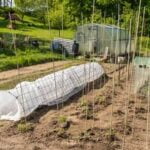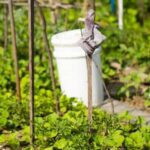Are you interested in exploring a space-saving and productive way to grow your own vegetables at home? Multi level PVC vegetable container gardens may be the perfect solution for you. This innovative gardening method allows you to maximize your growing space and create a beautiful and bountiful garden, even in limited areas such as balconies, patios, or small yards.
PVC (polyvinyl chloride) is a versatile and durable material that has become increasingly popular for creating multi level container gardens. Its flexibility and affordability make it an excellent choice for DIY gardeners looking to create a customized growing space. From herbs to tomatoes, peppers, and leafy greens, the possibilities are endless with a multi level PVC vegetable container garden.
In this article, we will explore the benefits of using PVC for container gardens, how to select the right location and space for your multi level garden, tips on choosing the right vegetables for this type of gardening, designing and assembling your garden, maintenance and care tips, as well as success stories and inspiration from fellow container gardeners.
Whether you’re a beginner or experienced gardener, there’s something in this article for everyone looking to start their own multi level PVC vegetable container garden.
Benefits of Using PVC for Container Gardens
PVC, or polyvinyl chloride, is a popular material for creating multi level container gardens for growing vegetables. There are several benefits to using PVC for this type of gardening.
One of the main advantages of using PVC for container gardens is its durability. PVC is resistant to rot, corrosion, and pests, making it an ideal material for outdoor use. This means that your multi level PVC vegetable container garden will have a longer lifespan and require less maintenance compared to other materials.
Another benefit of using PVC for container gardens is its versatility. PVC pipes and fittings can be easily assembled and customized to create multi level structures that fit your space and gardening needs. Whether you have limited space on a balcony or want to optimize a small backyard, PVC allows you to design and build vertical gardens that maximize space and productivity.
Additionally, PVC is cost-effective and readily available. Compared to other materials used for constructing multi level container gardens, such as wood or metal, PVC is more affordable and can be found at most hardware stores. This makes it an accessible option for beginner gardeners or those on a budget.
Overall, the use of PVC for multi level vegetable container gardens offers durability, versatility, and affordability. These benefits make it an attractive choice for gardeners looking to create efficient and productive growing spaces in limited areas.
| Benefits | Explanation |
|---|---|
| Durability | PVC is resistant to rot, corrosion, and pests |
| Versatility | PVC pipes can be easily assembled and customized to fit any space |
| Affordability | PVC is more affordable than other materials used for container gardens |
Selecting the Right Location and Space for Multi Level Container Gardens
When it comes to setting up a multi level PVC vegetable container garden, selecting the right location and space is crucial for success. The first step is to find an area that receives at least 6-8 hours of direct sunlight daily, as most vegetable plants require ample sunlight to thrive. This can be a balcony, patio, or any sunny spot in your yard.
In addition to sunlight, you’ll also need to consider access to water and convenience. Make sure the location has easy access to a water source, as container gardens may require more frequent watering than traditional gardens. Also, consider proximity to your home so that tending to your garden is convenient and enjoyable rather than a chore.
Space is also an important factor when planning a multi level PVC vegetable container garden. Consider the weight of the containers and soil once filled, as well as their stability when stacked on top of each other. Ensure that the area you choose can accommodate the size and weight of your containers without posing any safety risks.
Lastly, consider the aesthetics of the area you choose for your multi level PVC vegetable container garden. Whether it’s a corner of your balcony or a designated spot in your yard, ensure that it complements the overall look of your outdoor space while still providing enough room for growth and productivity.
By carefully selecting the right location and space for your multi level PVC vegetable container garden, you’ll set yourself up for a successful and bountiful harvest of fresh vegetables right at home.
Choosing the Right Vegetables for a Multi Level Container Garden
When it comes to choosing the right vegetables for a multi level PVC container garden, it’s important to consider the space and sunlight available for each level. One of the key benefits of multi level container gardening is the ability to grow a variety of vegetables in a small amount of space. This means that you can choose different types of vegetables that have varying sunlight and spacing requirements.
For the top level of your multi level PVC container garden, consider growing vegetables that require full sun, such as tomatoes, peppers, or eggplant. These plants need plenty of light to thrive and will do well in the higher levels where they can soak up the sunlight.
In the middle levels, you can plant vegetables that are more flexible when it comes to sunlight and spacing. For example, lettuce, spinach, or herbs like basil and cilantro are great options for these levels. They don’t require as much direct sunlight as other vegetables and can be grown in smaller spaces.
Lastly, for the lower levels of your multi level PVC container garden, consider root vegetables like carrots, radishes, or beets. These vegetables do well in partial shade and their roots will have plenty of room to grow downwards in the deeper containers.
By carefully selecting a variety of vegetables with different sunlight and spacing needs, you can maximize the productivity of your multi level PVC container garden and enjoy a bountiful harvest throughout the growing season.
Designing and Assembling a Multi Level PVC Vegetable Container Garden
When it comes to creating a multi level PVC vegetable container garden, the design and assembly process is crucial for the success of your garden. Here are some important steps to consider when creating your own multi level container garden using PVC:
1. Plan your layout: Before you start assembling your multi level PVC vegetable container garden, it’s important to plan out the layout. Consider the size and space available, as well as the types of vegetables you want to grow. Create a design that allows for easy access to all levels and ensures that each plant has enough room to grow.
2. Assemble the PVC structure: Once you have your design in place, it’s time to assemble the PVC structure for your container garden. Cut the PVC pipes to the desired lengths and use connectors to create the different levels of your garden. Make sure everything is secure and stable before moving on to the next step.
3. Add containers and soil: After building the PVC structure, it’s time to add containers and soil for planting. Use a mix of different sized pots or containers that fit within the levels of your PVC structure. Fill each container with nutrient-rich soil that is suitable for growing vegetables.
4. Plant your vegetables: Once everything is set up, it’s time to plant your chosen vegetables in each container. Make sure to space them out properly and provide adequate water and sunlight for healthy growth.
By following these steps, you can create a successful multi level PVC vegetable container garden that will provide you with a bountiful harvest of fresh produce right at home.
Maintenance and Care Tips for Successful Container Gardening
Watering and Drainage
One of the most important aspects of maintaining a successful multi level PVC vegetable container garden is proper watering and drainage. Since containers can dry out quickly, it’s essential to water your plants regularly, especially during hot weather. However, overwatering can also be detrimental to the health of your vegetables. Ensure that your containers have adequate drainage holes to prevent waterlogged soil, which can lead to root rot.
Fertilizing and Soil Care
In order to ensure healthy growth and abundant harvests, it’s important to fertilize your multi level PVC vegetable container gardens regularly. Choose a high-quality fertilizer that is suitable for the specific vegetables you are growing. Additionally, keep an eye on the condition of the soil in your containers. Over time, the soil may become depleted of nutrients, so it’s beneficial to refresh it with new compost or potting mix.
Pest and Disease Management
Container gardening can sometimes make plants more susceptible to pests and diseases since they are in close proximity and not as naturally insulated as they would be in a traditional garden bed. Regularly inspect your plants for any signs of pests or disease, such as yellowing leaves or unusual spots.
Consider using natural pest control methods such as introducing beneficial insects or using insecticidal soap if necessary. Additionally, maintain good air circulation around your plants to help prevent the spread of disease.
By following these maintenance and care tips for successful container gardening, you can ensure a bountiful harvest from your multi level PVC vegetable container gardens. Remember that consistent attention and care will go a long way in promoting the health and productivity of your container-grown vegetables.
Tips for Maximizing Space and Productivity in Multi Level Container Gardens
Container gardening is a great way to grow vegetables in limited space, and multi level PVC vegetable container gardens take this concept to the next level by maximizing space and productivity. With these innovative gardens, you can grow a variety of vegetables in a small area, making it ideal for urban gardeners or those with limited outdoor space.
Vertical Gardening
One of the key ways to maximize space in multi level PVC vegetable container gardens is through vertical gardening. By utilizing vertical space, such as walls, fences, or trellises, you can grow more plants in the same footprint. This is especially useful for vining plants like tomatoes, cucumbers, and peas, which can be trained to grow upwards rather than sprawling out across the ground.
Companion Planting
Another tip for maximizing productivity in multi level container gardens is to practice companion planting. This involves planting different vegetables together that benefit each other in some way, such as repelling pests or improving soil fertility. For example, planting basil alongside tomatoes can improve the flavor of the tomatoes and help repel pests that may affect both plants.
Succession Planting
Succession planting is also key to maximizing space and productivity in multi level PVC vegetable container gardens. This involves planting new crops as soon as one crop finishes producing, ensuring that your containers are always filled with growing vegetables. By planning your plantings carefully and rotating crops throughout the growing season, you can harvest multiple yields from the same containers.
By incorporating these tips into your multi level PVC vegetable container garden, you can make the most of your limited space and enjoy a bountiful harvest of fresh homegrown produce.
Success Stories and Inspiration for Successful Multi Level PVC Vegetable Container Gardens
Container gardening has gained popularity in recent years, especially with the rise of urban and small-space living. Multi level PVC vegetable container gardens have become a popular choice for many gardeners due to their versatility and space-saving design. These unique gardens allow for multiple levels of planting, making the most of vertical space and maximizing productivity.
One of the main benefits of multi level PVC vegetable container gardens is their ability to accommodate a variety of vegetables in a compact area. This type of gardening is especially beneficial for those with limited outdoor space or for those looking to add greenery to their patio or balcony. The use of PVC material also makes these gardens lightweight, durable, and weather-resistant, offering an ideal solution for year-round gardening.
If you are looking to start your own multi level PVC vegetable container garden, there are plenty of success stories and inspiration to draw from. Many gardeners have found creative ways to design and assemble their container gardens, showcasing how versatile and practical this method of gardening can be. From hanging gardens to tiered planters, there are endless possibilities for creating a stylish and productive multi level PVC vegetable container garden.
To get started on your own multi level PVC vegetable container garden, consider drawing inspiration from successful examples online or in your community. With careful planning and creativity, you can create a beautiful and bountiful garden right in your own backyard or outdoor space.
- Research different designs and layouts
- Utilize vertical space effectively
- Consider companion planting for a productive garden
Conclusion and Tips for Getting Started on Your Own Multi Level PVC Vegetable Container Garden
In conclusion, multi level PVC vegetable container gardens are a great solution for those with limited space or poor soil quality. The use of PVC offers various benefits, including affordability, durability, and versatility.
By choosing the right location and selecting the appropriate vegetables for your garden, you can create a productive and thriving multi level container garden. Designing and assembling the garden requires careful planning and attention to detail, but with the right maintenance and care, your garden is sure to flourish.
To get started on your own multi level PVC vegetable container garden, consider maximizing space and productivity by using vertical space and incorporating trellises for climbing plants. Success stories from other gardeners can provide inspiration and valuable tips for creating a successful multi level container garden.
Remember to stay consistent with watering and fertilizing your plants, as well as monitoring for pests or diseases. With dedication and patience, you can enjoy the rewards of fresh produce grown in your very own multi level PVC vegetable container garden.
Whether you’re a seasoned gardener or just starting out, a multi level PVC vegetable container garden is a rewarding project that can provide an abundance of fresh produce right at your fingertips. So roll up your sleeves, gather your materials, and get ready to embark on the journey of creating a beautiful and bountiful multi level PVC vegetable container garden. Happy gardening.

If you’re looking to get into vegetable gardening, or are just looking for some tips on how to make your current garden better, then you’ve come to the right place! My name is Ethel and I have been gardening for years. In this blog, I’m going to share with you some of my best tips on how to create a successful vegetable garden.





